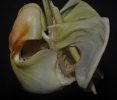|
|
|
|
|
| |
Established Seedlings of
Coryanthes bruchmuelleri 'No. 2 - RS' × self |
|
| |
|
|
| |
| Number: |
TN8866 |
| Name: |
Coryanthes bruchmuelleri 'No. 2 - RS' × self
|
| Type: |
self (What's that?) |
|
Click to Enlarge

Pod Parent Flower |
|
|
|
| |
For additional origin/habitat information supplied courtesy of
Charles and Margaret Baker, see further below, near the bottom of this page.
|
Temperatures we attempt to use in the lab & greenhouse:
| For Species: |
|
Spring, Summer, Autumn, Winter: days average 82°F, nights 63°F; best fit is Intermediate 83-60°F
(Source:
Baker's Web OSC) |
|
About the name...
| Etymology of |
bruchmuelleri |
|
Named for A. Bruchmüller, German collector in South America in the 19th century.
(Source:
Mayr & Schmucker 1998) |
| Etymology of |
Coryanthes |
|
From Greek "korys" helmet; "anthos" flower.
(Source:
Pridgeon 1992) |
| Pronunciation of |
Coryanthes |
|
ko-ree-AN-theez
(Source:
Pridgeon 1992) |
|
If you would like to direct someone to this web page, please copy and paste this URL into your email:
http://troymeyers.com/d?128866
ESTABLISHED SEEDLINGS
of these are not currently available.
We do not have any unsold in the greenhouse, but may offer them in the future.
Click here to see if we have flasks available.
|
|
|
| |
The origin/habitat information below is supplied courtesy of Charles and Margaret Baker
The following information is based on the name of the plant provided by the donor, and assumes that the name is correct. If the plant has been misidentified, then the following information may not be correct.
This text is copyrighted by the Bakers and may not be reproduced without permission.
ORIGIN/HABITAT: Venezuela, Brazil, and Peru. In Venezuela, plants are
found near Calderas in Barinas state at about 3000 ft. (910 m). No other
habitat details were given. Dunsterville and Garay (1966) report that this
species is also found in Brazil and Peru. In Brazil, plants grow in the
Amazonas region, but details of habitat location and elevation were not
given. In Peru, plants are found in the Department of Amazonas near
Manáos.
More about this information and the Bakers...
|
|
|
| |
|
|
|